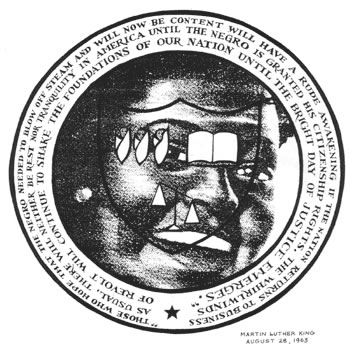|
by Sundiata Keita
Cha-Jua
“If the strict law of right
and justice is observed, the country around about me,
or the sunny South, is the entitled inheritance of the
Americans of African descent, purchased by the invaluable
labor of our ancestors, through a life of tears and
groans, under the lash and the yoke of tyranny.” Anonymous
North Carolina Black man quoted in James McPherson,
The Negro’s Civil War (New York: Ballentine), p. 298.
For decades the African American quest for reparations
was confined to fringe nationalist advocates such as
Arthur Anderson, the Republic of New Africa, and N’COBRA,
the National Coalition of Blacks for Reparations in
America. Malcolm X broached the issue, though only in
the last year of his life.
But now a sea change has occurred. Today, reparations
has emerged as a major issue on African Americans’ political
agenda, and has stimulated a strong movement struggling
to make it a reality. The California General Assembly
and nearly a dozen city councils have passed pro-reparations
resolutions.
Yet the public remains misinformed. Most Americans believe
that the reparations movement is a recent phenomenon,
a response to the reduction or elimination of affirmative
action programs. Reparations has also been misrepresented
as simply compensation for slavery. A year ago, conservative
activist David Horowitz exploited this distortion in
a paid editorial advertisement which appeared in campus
newspapers across the country. Responding to reparations’
historical misrepresentation in a 1994 article in African
Studies Review, political scientist Ali Mazuri remarked,
“We are dealing not merely with the history of bondage,
but also with the bondage of history.” The purpose of
my article is to shatter these shackles of misconception
by presenting the movement’s history and perspective.
The movement’s origin is located in the philosophy and
practices of the freed people. Its history can be divided
into four periods: (1) 1862-1870; (2) 1890-1917; (3)
1969-1975; and (4) 1987 to the present. During each
period, African Americans pursued reparations via a
variety of tactics, including legislation and litigation.
Like the anonymous African American quoted in the epigram,
most freed people
in the first period believed that their former masters’
land belonged to them by right of toil and survival
of American terrorism. Baylay Wyatt, a freedman from
Yorktown, Virginia argued, “I may state to all our friends,
and all our enemies, that we has a right to the land
where we are located. For why? I tell you. Our wives,
our children, our husbands, has been sold over and over
again to purchase the lands we now locate upon; for
that reason we have a divine right to the land.” Shifting
his argument from physical and mental abuse to labor
exploitation, Wyatt rhetorically asked, “And didn’t
we clear the lands and raise the crops ob corn, ob cotton,
ob tobacco, ob rice, ob sugar, ob everything? And den
didn’t the large cities in de North grown up on de cotton
and de sugars and de rice dat we made? I say dey have
grown rich and my people is poor.” Wyatt’s deceptively
simple words speak volumes about the freed people’s
understanding of the relationship between slavery and
America’s economic development.
This perspective was shared by some Union Army officers
and Congresspersons. For instance, General Tecumseh
Sherman issued Special Field Order No. 15 in 1862, reserving
the lands south of Charleston, the Sea Islands, and
along the St. John’s River in Florida for “the settlement
of negroes.” After President Andrew Johnson restored
the land to the former Confederate leadership, Blacks
fought the Union Army. Defeated, they pursued the acquisition
of land through other means.
In March of 1867, Pennsylvania Congressman Thaddeus
Stevens embedded the freed people’s logic in House Resolution
29. This bill allocated 394 million acres, to be taken
from the largest 70,000 southern landowners, to the
head of each freed family in 40-acre plots, and awarded
them fifty dollars. Stevens’ bill failed. So did H.R.
1119, Oklahoma Representative William J. Connell’s 1890
Ex-Slave Pension and Bounty bill.
In the second period, beginning in 1890, five similar
bills were introduced, but also defeated.
Perhapsthe first reparations lawsuit was filed in the
District of Columbia in 1920. Four African Americans
unsuccessfully sued the Treasury Department, claiming
it owed Blacks $68,073,388.99 for taxes collected on
cotton between 1862-1868. The suit was brought as a
class action financed by Callie D. House, leader of
the National Ex-Slave Mutual Relief Bounty and Pension
Association.
Just a year after this suit was brought, there began
a violent onslaught against entire African American
communities to drive them out and take their lands.
In 1921, the African American community in Tulsa, Oklahoma
was destroyed by a racist mob. And in 1923, African
Americans in the all-Black town of Rosewood, Florida
experienced a similar pogrom. Many of the residents
were massacred in both Tulsa and Rosewood.
The survivors and descendants of these atrocities finally
won legal damages in the mid-nineties in Rosewood, and
in 2000 in Tulsa. Also, in 1997-98, Black farmers across
the South won a $1 billiondiscrimination suit against
the U.S. Department of Agriculture.
These victories have energized a high-powered legal
team led by Harvard Law School professor Charles Ogletree,
Johnnie Cochran, Alexander Pires Jr., and Richard Scruggs.
Ogletree believes that victories in cases like Rosewood
and Tulsa have altered the political climate and established
legalprecedents for reparations.
At the heart of their complex legal strategy lies an
understanding that the demand for reparations encompasses
not only slavery itself but also post-slavery racial
violence, labor exploitation, and discrimination in
all aspects of economic and social life. For instance,
historians have documented approximately 3,000 African
Americans who were murdered, and their civil rights
violated, by lynch mobs between 1882 and 1930. Political
economists have shown that for about a century following
Emancipation, Blacks received 50 to 66 percent what
Whites were paid, though they often performed similar
work. It was not until 1948 that the practice of paying
Black school teachers half as much as White teachers
was declared illegal in Alston v. School Board of Norfolk,
Virginia. Moreover, Blacks were initially excluded from
large-scale social programs such as those initiated
by the 1862 Homestead Act, the 1935 Social Security
Act (which originally excluded domestic and agricultural
workers and thus 66 per cent of all Black workers),
and the 1949 act creating the Federal Housing Authority.
Finally, “Torn from the Land,” a pathbreaking investigation
by the Associated Press, recently documented “a pattern
in which black Americans were cheated out of their land
or driven from it through intimidation, violence and
even murder.” (http://wire.ap.org/APpackages/torn/)
In sum, Black demands for reparations seek redress not
just for slavery, but for a pre- and post-slavery legacy
of White supremacy and a living history of labor exploitation,
land appropriation, racist violence, and social discrimination.
The righteous premise is, as Robert Westley wrote in
1998, “that the victims of unjust enrichment should
be compensated.”
Sundiata Keita Cha-Jua directs the
Afro-American Studies and Research Program and teaches
History at UIUC, and is a member of the Black Radical
Congress.
|
|






